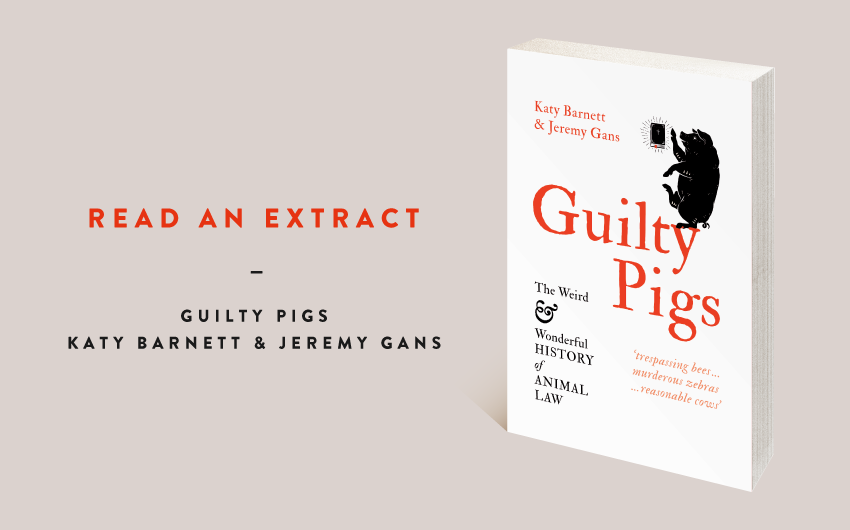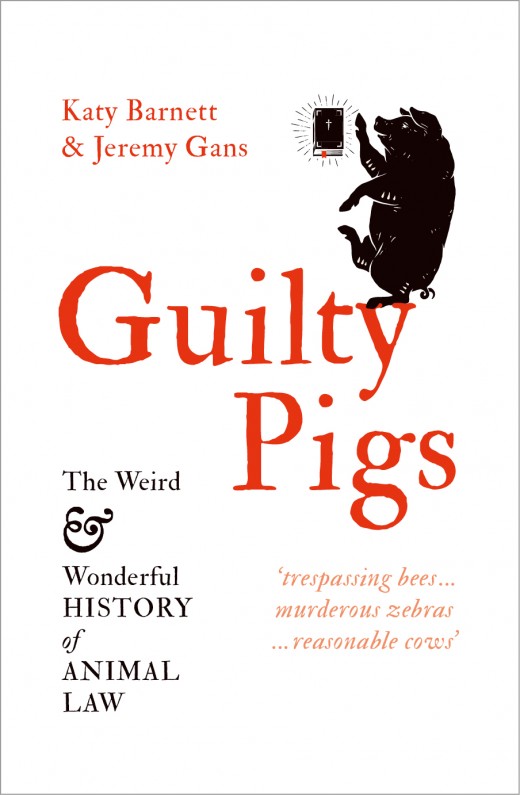News

News > Extract
Read an extract: Guilty Pigs
Trespassing bees, murderous zebras, reasonable cows ... Ever since biblical times, animals have been clashing with human laws. In Guilty Pigs, animal law experts Katy Barnett and Jeremy Gans guide readers through the philosophy and practice of animal-related law, from the very earliest cases to the issues we are debating today, including the responsibilities of pet owners and the application of human rights to animals. Read an extract.
On a cold day in Toronto in December 2012, shoppers at the IKEA furniture chain were astonished to see a small, lost-looking monkey, wearing a sheepskin-lined coat, wandering unaccompanied around the store. He quickly became known as the ‘IKEA monkey’ and was an internet sensation, immortalised in memes, games and cartoons.
In fact, the Japanese macaque was named Darwin, and he was owned by the lawyer Yasmin Nakhuda, who had a penchant for exotic animals. Darwin had escaped from a crate in the back seat of Nakhuda’s car in the shopping mall’s car park. Once the monkey’s presence was reported by agog shoppers and onlookers, Toronto Animals Services (TAS) collected the monkey and took him to their shelter. TAS did not have appropriate facilities for Darwin, for the very good reason that it was illegal to keep monkeys in Toronto. Nakhuda had obtained the monkey from a shady and mysterious exotic-animal dealer called Ayaz, for the sum of C$5000.
Shortly after Darwin was taken to TAS’s shelters, Nakhuda rang Ayaz and sought his help in retrieving the monkey, but given the publicity he had already attracted on social media, Ayaz refused. Nakhuda, who later gave evidence that she regarded Darwin as ‘a member of her family’ and her ‘son’, was distressed. She went to TAS’s offices to demand that TAS return Darwin to her, but they denied her request on the basis that Nakhuda could not prove that Darwin was vaccinated, and he might be carrying diseases. If Darwin tested positive for hepatitis B (fatal to humans) or another disease, TAS said, they would have the authority to euthanise him. If he were disease-free, Darwin would be transferred to a primate sanctuary. Eventually, he ended up at Story Book Farm Primate Sanctuary.
Questions of ownership of animals can arouse strong passions and lead to legal proceedings, as the case of Darwin the Japanese macaque shows. But it is a fair bet to say that many of us – especially non-lawyers and those of us who have not had disputes over ownership of animals – have not thought deeply about what it means when you say that you ‘own’ an animal.
Ownership is a difficult concept. To say that one owns a thing is to say that one has certain rights and responsibilities in relation to that thing (as a whole, or just certain attributes of it). If you own this book – presuming it is a hard copy – you may scribble all over it, tear out the pages, burn it, give it away to a friend, abandon it, loan it out for a fee or sell it second-hand. Of course, we hope you like it enough that you do not do most of these things, but they are all among the ‘bundle of rights’ that come with ownership. However, if you do not own this book and, in fact, have borrowed it from a library or a friend, the situation is different. You do not have the same rights over the book: you cannot destroy it, deface it, give it away or so on. Property rights define our relationship with things (including different sorts of property, such as land and copyright), but, crucially, they also define the rights of other people in relation to those things. If you do not own this book, the owner can get compensation from you if you damage or destroy it, through the law of tort (wrongs).
To say we have ownership of animals has certain ramifications. Think about what you could do with this book if you owned it, and apply those same rights to an animal. To own an animal might mean we have the right to control it, to sell, lease or give it to another person, to abandon or kill it, to exclude others from using the animal without permission, to take produce from the animal (its milk, fleece and so on) or take its offspring away.
There is a relationship between controlling something and owning it, but the two concepts do not match up exactly. Sometimes, the law legitimates pre-existing control or allocates control over things to certain people. The easier an animal is to control, the easier the animal is to own. Therefore, the ownership of bees has been a consistently difficult legal question in a number of cultures throughout the ages.
In Yanner v Eaton, a 1999 Australian case involving questions of ownership over wild crocodiles, four judges of the High Court noted that it is very hard to define what property is, particularly in relation to wild animals:
‘Property’ does not refer to a thing; it is a description of a legal relationship with a thing. It refers to a degree of power that is recognised in law as power permissibly exercised over the thing. The concept of ‘property’ may be elusive. Usually it is treated as a ‘bundle of rights’. But even this may have its limits as an analytical tool or accurate description, and it may be, as Professor Gray has said, that ‘the ultimate fact about property is that it does not really exist: it is mere illusion’.
In this chapter, we’ll see that property rights in animals are different in various cultures and have changed over time. This also reflects the malleability of the concept of ownership itself. Ownership is shaped by law, culture and history.
The linguistic history of our property law reveals how deeply the notion of owning animals is embedded in Western culture. ‘Chattel’ – the legal word for a ‘good’ or an article of movable property – is related to the word ‘cattle’. The eighteenth-century judge and jurist Sir William Blackstone noted that both words are derived from catalla, a Latin word that was primarily applied to farm animals, but also to all movable property. In fact, in some ancient societies, and even some modern ones, productive beasts, such as cattle, functioned as currency and status markers. The ancient Irish saga Táin Bó Cúailnge revolves around a planned theft of cattle: Queen Medb of Connacht and her husband, King Ailill, plan to steal a stud bull from King Conchobar Mac Nessa, of Ulster, to ensure Medb’s herd is equal to her husband’s. Later, in Irish Brehon law, cows, pigs and horses were effectively units of currency, with dairy cows the most prized item.
This leads us to consider why human animals might want to own other animals. There are many reasons, which shows us that ownership is complex and not the expression of one single desire or policy. People may wish to own animals for their companionship, to protect or take responsibility for them, to eat them, to use the resources they produce, for self-protection, warfare, labour, transport, sport or profit, as an exemplar of status or, in the case of certain wild animals, as objects of fascination or symbols of human domination over nature.
Although Mesopotamian laws clearly contemplated property rights in animals, the first ancient legal system to outline a complete and structured notion of such rights was Roman law. It distinguished between ownership of wild animals (ferae naturae) and domestic animals (mansuetae naturae). Only qualified ownership of wild animals was possible, but domestic animals could be owned completely. The distinctions and principles present in Roman law have since been adopted and adapted by the common law, including modern Australian law, and the Latin terms for wild and domestic animals continue to be used in legal cases and textbooks to the present day.
The distinction between wild and domestic animals is complex. Indeed, Fabrice Teletchea, an ecologist and zoologist, says that ‘wild and domesticated animals should not be considered as complementaries (such as true/false, dead/alive) but rather as antonyms (such as long/short, fast/slow), because they represent the extremes of a process and not a simple dichotomy’.
There is a further difference to note between domesticated and tame animals. Domesticated animals are animals that are selectively bred to have certain genetic characteristics, including a tolerance of humans. Even when they are reintroduced to the wild and have been feral for thousands of years, like the Australian dingo, they are genetically distinct from their wild counterparts. Conversely, tame animals are wild animals that have been taught by exposure to be tolerant of, and useful to, humans, but they otherwise remain indistinguishable from their counterparts in the wild. Thus, for example, elephants in a zoo are genetically no different to wild elephants, whereas domesticated dogs are genetically quite different to wolves, even if they return to the wild.
In this book, we see that the law does not consistently apply these distinctions between wild and domestic animals and domesticated and tame animals: it applies them in a particular way to ownership of animals and in another way when establishing whether an animal keeper is strictly liable for damage caused by animals for the purposes of scienter, a law that covers owners of intrinsically dangerous animals.
This is an extract from Guilty Pigs by Katy Barnett and Jeremy Gans. To read more, order Guilty Pigs – out now.
Share this post
About the authors
Katy Barnett is a professor of law at the University of Melbourne. She is the author of the young adult novel The Earth Below and co-author of Remedies in Australian Private Law.
More about Katy Barnett
Jeremy Gans is a professor of law at the University of Melbourne. He is the author of Modern Criminal Law of Australia and The Ouija Board Jurors: Mystery, Mischief and Misery in the Jury System, a true crime book. He is a co-author of Uniform Evidence.
More about Jeremy Gans



